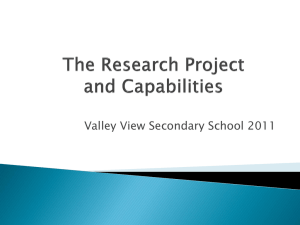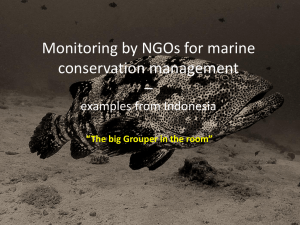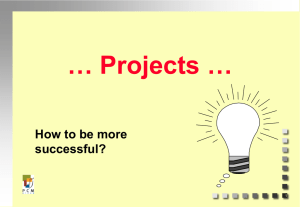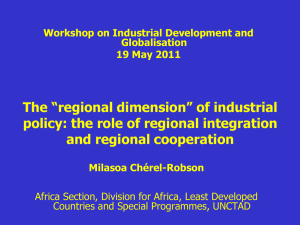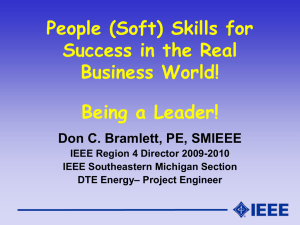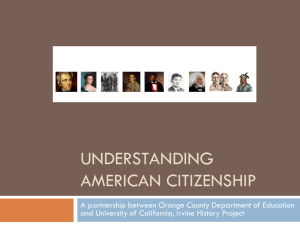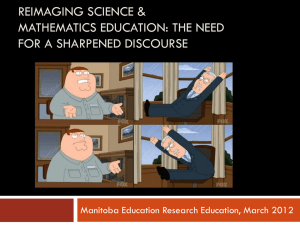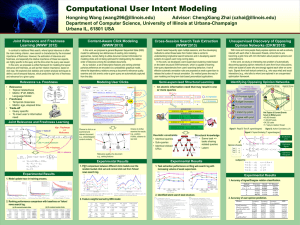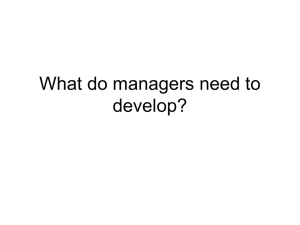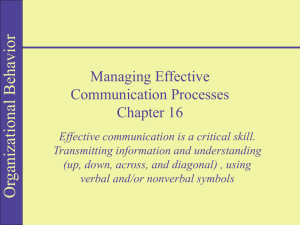Title of Presentation
advertisement
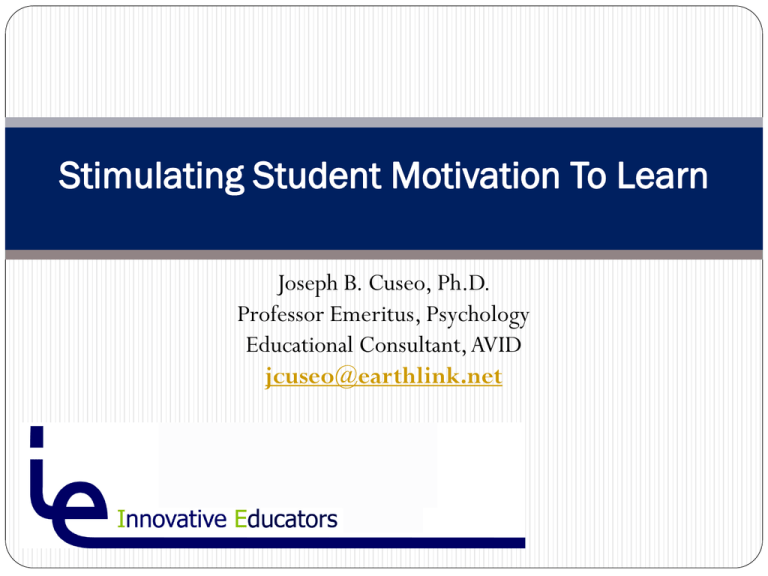
Stimulating Student Motivation To Learn Joseph B. Cuseo, Ph.D. Professor Emeritus, Psychology Educational Consultant, AVID jcuseo@earthlink.net OVERVIEW & PREVIEW OF WEBINAR CONTENT 1. Working Definition of Student Motivation 2. Key Distinctions: Extrinsic vs. Intrinsic Motivation 3. Key Suppositions/Propositions about the Nature of Student Motivation 4. Key Principles of Student (Human) Motivation Working Definition Student Motivation: The determination, drive, or will to learn. (Note: Motivation derives from the Latin roots “movere” and "motare"—meaning to move, shake or stir.) Key Distinctions * Extrinsic Motivation: student learning that’s driven by external rewards or incentives—i.e., learning engaged in as a “means to another end” or consequence—e.g., as means for obtaining a good grade, employment, or acceptance at another school. * Intrinsic Motivation: student learning that’s driven by internal/inherent interest in the learning task or learning process—i.e., learning that is self-rewarding or “end in itself ”—rather than as a means to another end. Question Do you agree or disagree with the following statement? “You can lead a horse to water but you can’t make him drink.” Classic Quote “The proper question is not, ‘How can people motivate others?’ but rather, ‘How can people create the conditions within which others will motivate themselves’?” —Edward Deci & Richard Flaste, WhyWe DoWhatWe Do: Understanding Self-Motivation Key Suppositions/Propositions * Student motivation and student learning are inextricably interrelated. * Student motivation involves a variety of underlying processes and is influenced by multiple dimensions of the self (e.g., personal attitudes, emotions, needs, beliefs, and values). * Student motivation is malleable and modifiable. * Student motivation is a measurable learning outcome. * Student motivation is a powerful learning outcome. Classic Quotes “Education is not the filling of a pail, but the lighting of a fire.” —William Butler Yeats, Irish poet and playwright “Collateral learning—the way of formation of enduring attitudes, of likes and dislikes—may be and often is much more important than the lesson in geography or history that is learned. The most important attitude that can be formed is that of desire to go on learning.” —John Dewey, American philosopher, psychologist and educational reformer Key Principles of Student (Human) Motivation 1. Personal Validation (Individual Affirmation) 2. Self-Efficacy (Self-Confidence & Self-Empowerment) 3. Meaning & Purpose (Perceiving Connections & Relevance) 4. Engagement (Active Involvement) 5. Social Integration (Belongingness) Question Which one of the five just-mentioned principles of student (human) motivation is most interesting to you or most relevant to your work with students? Personal Validation (Individual Affirmation) Student motivation is enhanced when students feel personally significant— i.e., when they feel recognized as individuals, that they matter to the institution, and that the institution cares about them as total (whole) human beings. Key Strategies: * Knowing Who Our Students Are: Learning Their Names & Referring to Them by Name * Knowing About Our Students: Using a Student Information Sheet to learn about our students’ personal backgrounds, future plans, abilities (talents), interests, values, learning expectations, habits and styles. Self-Efficacy (Self-Confidence & Self-Empowerment) Students are more likely to strive for and achieve success when they believe that their personal effort matters—when they think they can exert significant influence or control over the outcomes of their educational experience and their future success. Self-Efficacy (Self-Confidence & Self-Empowerment) Key Strategies: * Balancing Challenge & Support: “Scaffolding” to Create Moderate Challenge * Providing Effective Performance-Enhancing Feedback * Exposing Students to Successful/Inspirational Role Models (With Whom They Can Identify) MEANING & RELEVANCE (Perceiving Connections & Relevance) Motivation is strengthened when students find meaning or purpose in their learning experience—i.e., when they perceive relevant connections between what they’re learning in college, their current life, and their future goals. MEANING & RELEVANCE (Perceiving Connections & Relevance) Key Strategies: 1. Helping Students Make Meaningful Connections across the Curriculum & Co-curriculum a) Making connections across the curriculum (i.e., between courses and disciplines) b) Making connections between the curriculum and the cocurriculum MEANING & RELEVANCE (Perceiving Connections & Relevance) Key Strategies: 2. Helping Students Make Connections between Their College Experience & the “Real World” a) Relating academic learning to current, newsworthy events b) Engaging students in experiential learning (e.g., internships, service learning, co-curricular experiences) c) Using reality-simulating learning exercises in the classroom (e.g., simulations, scenarios, case studies, problem-based learning) MEANING & RELEVANCE (Perceiving Connections & Relevance) Key Strategies: 3. Helping Students Make Relevant Connections between College Learning and Their Personal Life a) Articulating learning outcomes that relate to the development of student skills and that connect with their personal goals b) Providing students with a rationale for why they’re learning what their learning and how they’re being asked to learn it c) Allowing students opportunities to make personal choices & decisions about what they will learn and how they will demonstrate what they have learned ENGAGEMENT (Active Involvement) Student motivation increases with the degree or level of student engagement in the learning process increases— both inside and outside the classroom. ENGAGEMENT (Active Involvement) Key Strategies: * Capturing Initial Interest & Curiosity: a) Intentionally titling learning topics to stimulate student interest b) “Setting the stage” for learning topic with a provocative prompt (e.g., a thought-provoking quote, provocative passage, powerful picture, intriguing artifact, or content-relevant cartoon) c) Starting the learning experience by creating cognitive dissonance (e.g., posing a controversial question, surprising or counterintuitive statement, dilemma or paradox). ENGAGEMENT (Active Involvement) * Recapturing Attention: a) Changing learning routines/formats (information presentation, whole-class discussion, small-group work, selfreflection exercises, guest speakers, panels, role plays) b) Changing modalities of sensory input and students’ seating location (physical movement) c) Capitalizing on human emotion (e.g., poignant pictures, drama, role play, games) ENGAGEMENT (Active Involvement) * Creating an Intentional Start-to-Finish Sequence of Student Engagement: a) At the start of the learning experience: Activate (Warm Up) b) During the learning experience: Punctuate (Break It Up) c) After the learning experience: Consolidate (Wrap It Up) Question Would you agree with the following statement? “If students are engaged (actively involved in a learning experience), they will learn from that experience.” Classic Quotes “We choose and engage in what we find most meaningful. Students are no exception, and they now have more choices on how to spend their time and invest themselves. Students can experience so much of the world today so easily, but do they forego the discipline and time to reflect, construct and create meaning from their exposure? Just being busy is insufficient.” —Larry Braskamp, Developing Global Citizens Classic Quotes [Effective colleges] “are not just fostering ‘engagement’ (as if simply being engaged in something, anything, were enough), they are helping students with their calling, something to be engaged about.” —Jon Wergin, Putting Students First: How Colleges Develop Students Purposefully SOCIAL INTEGRATION (Belongingness) Student motivation is strengthened when learning takes places within the context of human interaction, collaboration, and the formation of interpersonal relationships between the student and other members of the college community—faculty, staff, and peers. SOCIAL INTEGRATION (Belongingness) 1. Promoting Interpersonal Connections between Students and Faculty—inside and outside the classroom Key Strategy: The “Interactive Lecture”—Posing Open-Ended Questions (Divergent-Thinking) Questions during Informational Presentations SOCIAL INTEGRATION (Belongingness) 2. Promoting Interpersonal Connections between Students and Staff—interpersonal contact with student-support professionals Key Strategy: “Course-Integrated” Support—bringing student-support professionals to class as guest speakers or bringing students to student-support professionals via course assignments SOCIAL INTEGRATION (Belongingness) 3. Promoting Interpersonal Connections between Students and Their Peers: Key Strategies: a) Small-Group Discussions (Pairs, Triads, Quads) b) Collaborative Learning: students reach consensus in small groups c) Cooperative Learning: intentional, instructor-created learning teams who work as a team toward a common goal (unified work product) Question What unanswered questions do you still have, or what more would you like to know about student motivation? Recommended References Deci, E. L. (1975). Intrinsic motivation. New York: Plenum. Deci, E., & Flaste, R. (1996). WhyWe DoWhatWe Do: Understanding Self-Motivation. New York: Penguin. Deci, E. L., & Ryan, R. M. (1985). Intrinsic motivation and self-determination in human behavior. New York: Plenum. Dweck, C. S. (1999). Self-Theories:Their role in motivation, personality, and development. Philadelphia, PA: The Psychology Press. Ginsberg, M. B., & Wlodkowski, R. J. (2009). Diversity & motivation: Culturally responsive teaching in college. San Francisco: Jossey-Bass. Reeve, J. (1996). Motivating others: Nurturing inner motivational resources. Needham Heights, MA: Allyn & Bacon. Wlodkowski, R. J. (2008). Enhancing adult motivation to learn: A comprehensive guide for teaching all adults (3rd ed.). San Francisco: Jossey-Bass. Thank you Joseph B. Cuseo, Ph.D. Professor Emeritus, Psychology Educational Consultant, AVID jcuseo@earthlink.net Thank you for your participation!


